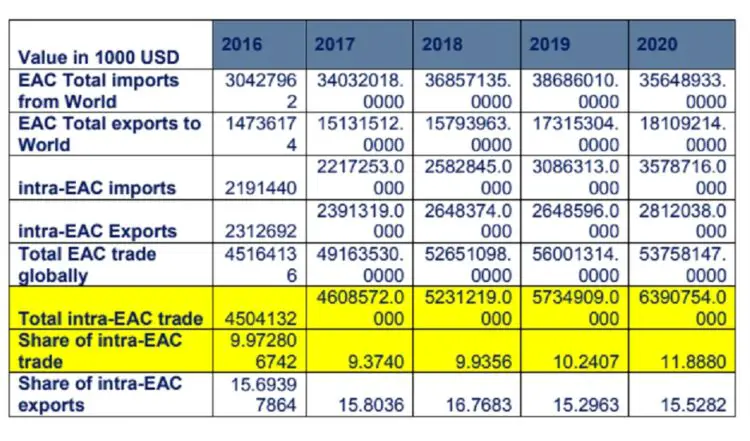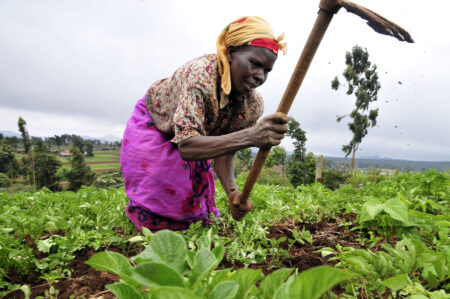- The proposed maximum CET rate for products falling under the fourth (maximum) band will substitute international trading partners for intra-regional trade
- Uganda will accrue the highest trade contribution at US$8.456 million, followed by Kenya at US$5.099 million and Rwanda at US$3.714 million
- In 2020, the total intra-EAC trade stood at 11.8 per cent, amounting to US$6.39 billion
- Under the current operational EAC CET structure, the maximum tariff is 25 per cent while the other three bands are 0 per cent and 10 per cent
The East African Community is looking to create a common market through a maximum CET rate in the region to ease the movement of factors of production and increase their bargaining power in the African Continental Free Trade Area (AfCFTA) and globally.
One of the bodies driving intra-EAC trade is the East African Business Council (EABC).
The East African Community Secretariat’s analysis has come up with a way to reduce cheap imports into the region, proving a mountain to climb for local producers.
The proposed maximum East African Community Common External Tariff (CET) rate of 35 per cent is set to boost intra-EAC trade by US$18.9 million if adopted by the EAC partner nations.
Read: Tanzania: Railway lowers freight costs, increases exports in EAC

The East African Business Council (EABC) urges the partner states- Kenya, Uganda, Tanzania, Burundi, Rwanda and South Sudan- to adopt the maximum CET tariff trade to spur industrialization and strengthen the regional value chain.
In 2020, the total intra-EAC trade stood at 11.8 per cent, amounting to US$6.39 billion. The proposed 35 per cent tariff is set to boost the trade between EAC member states to US$6.4 billion.
Under the current operational EAC CET structure, the maximum tariff is 25 per cent while the other three bands are 0 per cent and 10 per cent, with few sensitive products attracting higher tariffs ranging from 30 per cent to 100 per cent.
The 35 per cent CET rate is crucial to boosting the competitiveness of the East African manufacturing sector globally. The EAC Secretariat’s analysis shows if EAC member states adopt either the 30 per cent, 33 per cent or 35 per cent as the maximum CET rate, the total tax revenues will exponentially grow by 3.9 per cent, 4.9 per cent and 5.5 per cent, respectively.
The proposed maximum CET rate for products falling under the fourth (maximum) band will substitute international trading partners and favour intra-regional trade. Uganda will accrue the highest trade contribution at US$8.456 million, followed by Kenya at US$5.099 million and Rwanda at US$3.714 million.
Read: EAC: Uganda and Tanzania bury the hatchet to improve trade
The maximum CET rate creates employment opportunities in East Africa.
Adoption of the maximum CET rate will have the following changes in the employment creation sector:
- Thirty per cent maximum CET rate will increase employment by 0.02 per cent (5,055 people).
- The 33 per cent maximum CET rate will boost employment by 0.03 per cent (6,089 people).
- The 35 per cent maximum CET rate will increase formal employment in the region by 0.03 per cent (6,781 people).
The maximum CET rate will boost industrialization in East Africa.
A maximum CET trade will change industrialization with the following margins:
- Thirty per cent maximum CET rate will increase industrial output by 0.02 per cent (US$7.7 million).
- Thirty-three per cent will boost industrial output by 0.03 per cent (US$10.3 million).
- Thirty-five per cent- increases industrial output by 0.04per cent (US$12.1 million). Adopting this tariff rate will incentivize and protect budding industries exposed to unfair global competition and safeguard industries against cheap and subsidized imports and jobs.

A maximum CET rate to boost intra-EAC trade. [Photo/EABC]
The 35 per cent maximum tariff rate will also attract investments in industrial value chains and transform the EAC bloc into an export giant economy in the African Continental Free Trade Area and globally.
Most of the products assigned the maximum CET rate (4th band) are classified under the EAC priority value chains as provided by the EAC industrialization 2012-2032 policy.
The 35 per cent CET rate will offer the required adequate protection the region needs to drive regional value chains and transform industrialization through the fourth band products (textiles, iron, steel and motor vehicles).
Products in the EAC trade bloc face competition from cheap imports from the Asian continent; hence, they need higher rates to safeguard their production in the region.
The EAC member states consider commencing trade under the African Continental Free Trade Area (AfCFTA).
The East African Business Council is at the forefront to realise a successful intra-EAC trade.
Read: EAC: EABC, South Sudan discuss creating a single custom territory











